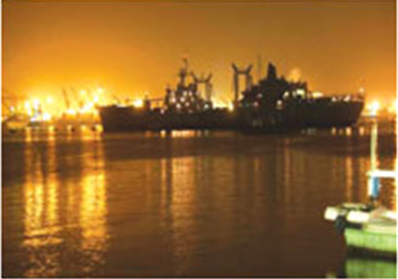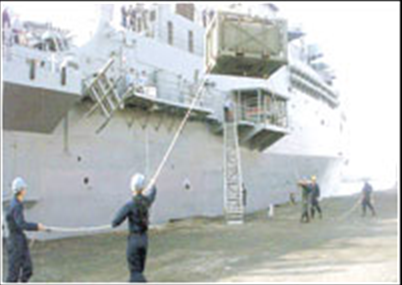Shipping: Pakistan
This is a collection of articles archived for the excellence of their
content. You can update or correct this page, and/ or send photographs to the Facebook page, Indpaedia.com. All information used will be duly acknowledged. |
Shipping Industry: Pakistan
On the verge of sinking
By Shamama Shabbir
The shipping industry in Pakistan needs immediate government attention
Pakistan’s shipping industry has not lived up to its potential. Before the subject is discussed, one finds it necessary to mention at the outset that when Pakistan came into being, it had inherited only three old steam ships and one deep-sea water functional port, namely the Karachi Port.
The shipping industry can be divided into three groups: cargo lifting, ship-building and ship-breaking. In the cargo lifting sector, which has a lot of growth potential since Pakistan is surrounded by neighbouring countries which are landlocked, we see that the strength of Pakistani flag vessels reached 71 in 1970 and has now been reduced to only 15. There are three operational ports, namely the Qasim International Container Terminal, the Pakistan International Container Terminal, the Karachi International Container Terminal and the forth, Gwadar will be operative shortly. This strong recession and the growth of the shipping sector are going in two different directions where trade is increasing but the number of national flag vessels are thinning. Hence the movement of cargo is being controlled by international/foreign lines which monopolise the trade through heavy freight rates.
Fortunately or unfortunately, Pakistan has only one national flag line, the Pakistan National Shipping Corporation (PNSC) working on a “one-ship-one-company-basis” and operating dry cargo vessels on “tramping”, that is, without any fixed schedule. The major part of the trade is taken care of by foreign flag vessels and nearly 45 companies are operational in Pakistan on the basis of feeder operators or the complete liner service.
The government’s shipping office was established at the Karachi Port on May 21, 1948, which was originally a subordinate office to the Ministry of Commerce, and was later placed under the administrative control of the Ports and Shipping Wing, Karachi (Ministry of Communications). The office of Ports and Shipping Wing was established in 1961 to bring the decision-making process closer to the shipping industry, mainly based in Karachi. Its primary function was to monitor, review and develop all marine activities in Pakistan keeping in view all the developments around the world. But because of the lack of clarity of goals and short-term decision-making, the industry was badly hurt and is still not given due attention.
The following facts and figures will give a better picture of the situation:
1947-1970
At the time of independence, Pakistan was divided into two wings, East Pakistan and West Pakistan. It used to be the most lucrative captive trade route but as it had only three vessels the private sector entered the arena to capture the trade. The private sector not only took care of the trade but also brought revenue to the state in the form of payments. The companies worth mentioning in this regard were Trans Oceanic, East & West Shipping, Gulf Shipping, Mohammadi Steam Ship, Pan Islamic Co, Chitttangon Shipping, and Bakslines. These private companies bought various vessels, that is, oil tankers for oil and liquid consignment, cargo ships for dry cargo and passengers ships which mostly catered to commuters travelling between east and west wings of the country, or who wanted to perform Haj and Umrah. In the late ‘50s, Pakistani vessels entered other regions and oceans and by 1962 the private sector had gathered a respectable fleet size.
In 1963, the government of Pakistan decided to have a national fleet along with the private one. This resulted in the formation of the National Shipping Corporation (NSC) and both private and public sectors operated freely adding to the (vessels/ships) fleet. The shipping policy of 1963 was very investment-friendly which was reflected in the form of an increase in the fleet. In 1960-62, the fleet strength of both public and private sectors became 41, which in 1971 became 70. This was also because of the trade between east and west wings and the opening of Indian ports for Pakistan’s fleet.
1971-1978
This phase can be dubbed the beginning of the dark ages for the shipping industry which still has its effects on the present shipping industry. The 1971 war left deep impressions on the industry as it resulted in the loss of a lucrative trade route between east and west wings, the loss of Indian ports and 17 vessels/ships. Private and the government sectors diverted their vessels to foreign routes and till 1973 the industry remained profit-oriented.
In 1974, the government haphazardly decided to nationalise the industry as nationalisation was the sole motto of that government. In January, 1974, nine private companies which were operational were bought through the Pakistan Shipping Corporation (PSC). Thus the private sector was no longer on the scene. The nine companies at the time had 26 ships with an average age of 19 years. The already existing national fleet NSC had 24 ships with an average age of about 12 years. In 1974, the entire shipping industry was run by the Nation Shipping Corporation and the Pakistan Shipping Corporation having the strength of 50 ships. Nationalisation was a major blow to the shipping industry which resulted in major fleet reduction, monetary loss, and the investors lost their trust in the lucrative industry. Between 1974 and 1978, the situation remained more or less stagnant.
1979-1992
With the promulgation of ordinance No XX of 1979 by the government of Pakistan, the National Shipping Corporation and the Pakistan Shipping Corporation were merged and the Pakistan National Shipping Corporation came into being, inheriting 41 ships.
Between 1971 and 1981 the PNSC added 14 vessels acquired from Japan, Holland and the UK. Subsequently, the vessels which had aged were scraped. In 1981, the National Tanker Company was established as a subsidiary of the PNSC to handle import of crude oil and the vessel that it first acquired was M.T. Johar.
Keeping with the trend, the PNSC again made an abrupt decision in 1979-1983 by ordering 14 ships which increased the liability of the company manifold. In the same period, local currency got rapidly devalued, having another negative impact on the Pakistan National Shipping Corporation. In 1982-84 the marine sector witnessed recession internationally because of the reduction in freight fares.
In 1993, the government deregulated shipping by awarding 36 licenses to intending shipping entrepreneurs out of which four companies — Tri Star Shipping, Ray Shipping, Mill Wala Shipping and Dewan Shipping — bought around eight ships which were gradually scrapped without any replacement. This brought an end to private shipping companies in Pakistan. Ever since the shipping industry in Pakistan has become gloomy and international liners are making the most of it. Have we ever thought of the amount of resources that we are losing by not supporting our industry?
If we look at the statistics given below, we will see how the Pakistani fleet has declined.
Pakistan Fleet since 1947
Year No. of ships Year No. of ships
1947 3 1977 49
1948 7 1978 48
1949 10 1979 48
1950 14 1980 50
1951 22 1981 50
1952 25 1982 50
1953 25 1983 41
1954 24 1984 34
1955 23 1985 31
1956 23 1986 29
1957 21 1987 26
1958 29 1988 23
1959 35 1989 23
1960 41 1990 22
1961 43 1991 22
1962 43 1992 22
1963 43 1993 22
1964 50 1994 13
1965 53 1995 15
1966 59 1996 17
1967 61 1997 25
1968 65 1998 25
1969 66 1999 15
1970 71 2000 15
1971 57 2001 14
1972 55 2002 14
1973 52 2003 14
1974 52 2004 14
1975 52 2005 15
1976 49 2006 15
Ship-building is a highly complex, competitive and capital-intense industry which requires long-term planning. In 1957, the Karachi shipyard and Engineering Worked Limited (KS&EW) was established with the funding of the government of Germany. The successful era of ship-building began in 1970 when it started getting international orders, and in 1971 the industry rose to its zenith when it built ships for Saudi Arabia, Belgium, Kuwait, Iran and the Peoples Republic of China. In 1990, it ventured into construction of warships and built a missile craft (PNS SHUJAAT) for the Pakistan Navy. It is the first state-owned industry to have ISO 9001:2000 certifications. It has built 434 ships, repaired 5,000 vessels and constructed over 2,000 heavy engineering units for local and foreign clients. But for a long time we have not seen much positive movement in this sector.
Ships to and from Karachi
Ship to Pakistan
AS a frequent traveller on ships to and from what used to be Bombay, I would like to refer to a news item on the Business page of your issue of February 14, Karachi-Mumbai ferry: service likely to start from June. As an eight-year old, I first took Scindia Steamship’s S.S. Sabarmati on September 3, 1950 when migrating from India to Pakistan. It was a new ship. Between 1950 to 1965 I made several voyages to Bombay and back on Sabarmati and its sister ship Saraswati. I was on the last but one voyage that Scindia’s ships and BI’s ships (Dwarka, Damra and Dara, the last-named ship sank on the Balochistan coast, while plying from Bombay to Basra, via Karachi) made between the two port cities of Pakistan and India. The services were stopped in September 1965 due to the ‘Indo-Pak armed conflict’, as it was then euphemistically called. The deck class fare was Rs 60 (one way) and second class cabin fare Rs 120. As a student I could not afford to pay first class cabin fare, hence I can’t remember the first class fare, except that it was more expensive than the return airfare (Rs 375 in the early sixties).
The Scindia ships used to weigh their anchors from Prince’s Docks in Bombay on Saturday around 5 pm and reach Keamari in Karachi on Monday early morning — a distance of about 500 miles in 38 hours. The return journey commenced on Monday at 5 pm.
The ships’ cruising speed was around 14 knots. (I don’t agree with the report in your paper that the ferry would cover the distance in 10 hours, even if it moves at 40 knots per hour, which seems unbelievably high).
The ships dropped anchor in the open sea near Mandvi (a town on the Kutch coast) and the passengers used to shift to country boats. That was convenient for passengers who wanted to take a train to cities in Gujarat from Mandvi. Those passengers were replaced by Indian passengers who boarded the ships for Bombay. It took less time than the train, which had a longer route. During monsoons – from May to September — when the sea was rough ships plied directly. Monsoons or no monsoons, BI ships didn’t drop anchor near the Kutch coast. They went straight from Bombay to Karachi and vice versa.
Steamships, like the ones described above, were considered out of date; the motor ships were more modern. MV Asia and MV Victoria used to link Karachi with the UK. The ship that carried the Pakistan cricket team to England in 1954 was MV Batory. Arrangements were made for net practice and a good number of balls were taken with the team for they often landed in the sea. The main ‘culprit’ was Merry Max, who was a hard hitter of the ball. He was to the 1954 team what Shahid Afridi is to our present team. If only he would have been born in the seventies or eighties to have played ODIs. ‘Hit out or get out’ was Merry Max’s maxim.
ASIF NOORANI Karachi

